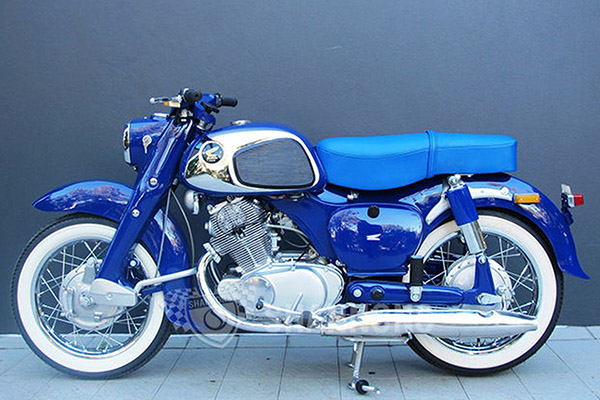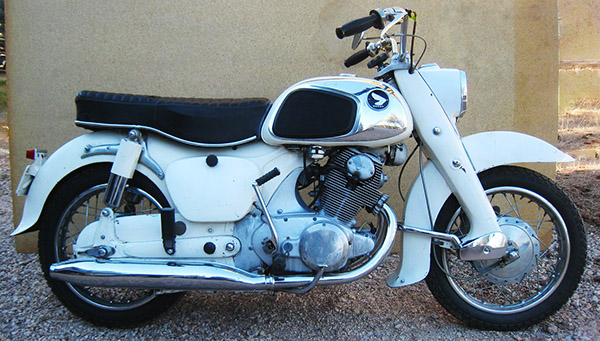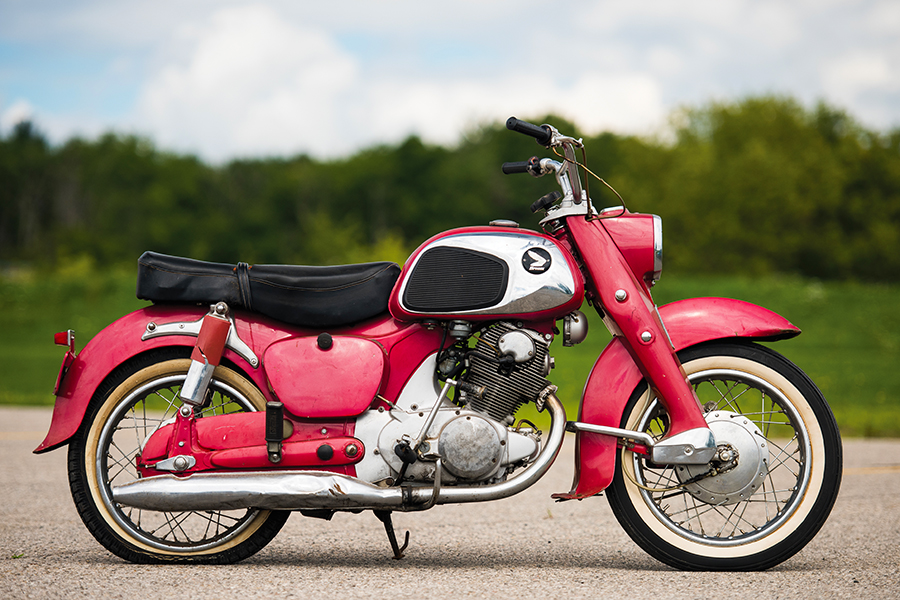My Dad and I saw our first Honda ever in 1964 at a McDonald’s in East Brunswick, New Jersey. It was a 150cc Dream, the smaller version of the bigger CA 77 305cc Dream. I was 12 years old at the time. In those days, it was a fun family outing to drive the 20 miles to Route 18 in New Jersey and have dinner at McDonald’s (that was the closest one), where hamburgers were 15 cents and the sign out front said they had sold over 4 million of the things. And the Honda we saw that day…Dad and I were both smitten by the baby Dream, with its whitewall tires, bright red paint, and the young clean cut guy riding it. True to Honda’s tagline, he seemed to be one of the nicest people you could ever meet (although admittedly the bar wasn’t very high for nice people in New Jersey).
Keep us in clover…please click on the popup ads!
Dad and I started looking into Hondas, and that included a trip to Cooper’s Cycle Ranch near Trenton. Back then, it really was a ranch, or at least a farm of some sort…the showroom was Sherm Cooper’s old barn. The little Hondas were cool, but the big ones (the 305s) were even cooler. A 305 was the biggest Honda available in the mid-1960s and Honda imported three 305cc motorcycles to America: The CA 77 Dream, the CB 77 Super Hawk, and the CL 77 Scrambler. The Dream was not designed to be an off road motorcycle (that was the CL 77 Scrambler’s domain) or a performance motorcycle (in the Honda world, that was the CB 77 Super Hawk).
Of the 305 twins, It’s probably appropriate to discuss the CA 77 Dream first. The Scrambler and the Super Hawk were intended to appeal to motorcycle enthusiasts; the Dream was a much less intimidating ticket in (into the motorcycle world, that is). The typical Dream buyer was either someone stepping up from a smaller Honda, or someone who had not previously owned a motorcycle.

Honda first used the name “Dream” on its 1949 Model D (a single cylinder, 98cc two-stroke). No one knows for sure where the Dream moniker came from, but legend has it that someone, upon first seeing the Model D, proclaimed it to look like a dream. The C-series Dreams first emerged in Japan in 1957. Pops Yoshimura built Honda engines with modified production parts that ran over 10,000 rpm for 18-hour endurance races, proving the basic design was robust. Some say Honda based the engine design on an earlier NSU engine, but Honda unquestionably carried the engineering across the finish line. Whatever. When’s the last time you saw an NSU? Another big plus was that Honda used horizontally split cases and that (along with vastly superior quality) essentially eliminated oil leaks. The other guys (and in those days, that meant Harley and the Britbikes) had vertically split cases and they all leaked. Honda motorcycles did not, and that was a big deal for a motorcycle in the 1960s.

There were several differences between the Dream and the other two Honda 305cc motorcycles. The Super Hawk and the Scrambler had tubular steel frames and forks; the Dream used pressed steel for both its frame and fork. The Dream was a single-carb motorcycle; the Super Hawk and the Scrambler had twin carbs. The Dream had large steel valanced fenders, the other Hondas had more sporting abbreviated fenders. The Dream was the only 305 that came from the Honda factory with whitewall tires. The Dream had leading link front suspension; the Scrambler and the Super Hawk had telescopic forks. The Dream used the Type II crankshaft (so did the Scrambler) with a 360-degree firing order (both pistons went up and down together, but the cylinders fired alternately). The higher performance Super Hawk had the Type I, 180-degree crankshaft. Like the Super Hawk, the Dream had electric starting (the Scrambler was kick start only). The Dream came with a kickstarter, too, but why bother? I mean, you weren’t going to be mistaken for Marlon Brando when you rode a Honda Dream.

The Dream’s 305cc engine had a single 23mm Keihin carb and it produced 23 horsepower at 7500 rpm (not that the rpm was of any interest; the Dream had no tachometer). With its four-speed transmission and according to magazine test results, the Dream was good for between 80 and 100 mph (depending on motojournalist weight, I guess). The Dream averaged around 50 mpg, although in those blissful days of $0.28/gallon gasoline, nobody really cared. Honda Dreams came in white, black, red, or blue. With 20/20 hindsight, I wish I had bought one in each color and parked them in the garage. My favorites were black or white; those colors just seemed to work with the Dream’s whitewall tires.
Honda built the Dream until 1969. The Dream retailed for $595 back in those days, but a shrewd negotiator could do better.
Never miss an ExNotes blog:
See our other Dream Bikes here!


And the 305 was succeeded by the legendary 350 on which I think most of us learned to ride. I had a 305 Super Hawk and then a CB 350. Went from the 350 to a 71 CB 750 Four. Such fantastic bikes. So dependable and could stand up to almost any kind of use or abuse. They had some kind of magic to them.
I had a ’71 CB 750, Bob. Great minds think alike.
Hondas e starts sucked.
Mine never worked. Thank god the kicker worked well.
The Dream has to be one of the fugliest motorcycles of all time.
I did have a superhawk .
Wasn’t bad . But it was still a Honda .
I would buy one today if one came up . Especially if the estart works.
I put the scrambler exhaust with the snuffer nuts on it. Rarely closed! Lol.
I didn’t ride to be a nice person . I was pure counter culture.
The scrambler is the bike that made Honda somewhat acceptable . Good looking motorcycle then , as it still is today .
I am going to go out on a limb here and say the CB 450 was before the CB350. So I disagree with the previous comment on the timeline.
Another thing , I am not sure what size the baby dream was. Very well could have been 150. But what sticks in my head , at least for “baby” hawks , was 160.
My memory does have occasional issues. But that’s how I remember .
In a time, to tough to die.
I think you are rght. I think the Bomber (the 450 with torsion bar valve springs) was on the market before the CB 350.
I had both the 160cc Dream and the 305cc Dream. I wasn’t a Dream fanatic, I got them because they fit my budget at the time. I didn’t pay more than $25 for any of them.
Once, I got two 305 Dreams for $15 each. One had a good engine, the other had a good transmission.
Swapping the parts impressed me how well the bikes were built. The engines were works of art.
Top speed was around 90 and cruising at 70 was no problem.
Yeah, but how much did you weigh back then?
Maybe 120 pounds!
impressed on how well the engines were?
i once junked a 71 SL175 because i got sick of the crappy phillips head screws they used on the cases .
i never took my 305 apart thankfully.i ditched it when the wheels fell apart.
JC whitney must have sold hundreds if not thousands of impact tools in the golden age of jap tiddlers.
the problem too was there was very little support from dealers. they were still selling triumphs and maybe even lawn mowers.
so lets not paint too rosey a picture of back then.
nobody told us they weren’t phillips but some jap derived head.
today there is plenty of support . but for a kid whom didn’t know what they were doing, honda was a mixed blessing. two carbs? was there 2 sets of points? i dont remember, but kids with ducati singles were having an easier time of it.
The first bike I actually owned was the CB350.
It was summer of 1970 in Orlando, FL . I was 16.
The first week I owned it, I was heading over to a friend’s pool wearing shorts, t-shirt and sneakers. The road had a sharp curve with some sand on the asphalt. I think you can figure out the rest…
I decided the CB350 was too big for me so I traded it for a 1969 Yamaha 125 Enduro.
DEET was born….
The entire motorcycle industry is built around convincing people to move up to a larger motorcycle. You went the other way. So did I.
Thanks for commenting.
i am now going the other way.
mostly old age related but new bikes are often “Tuna Barges” lol.
too big, too complicated, and too pricey.
on the crowded northeast coast line there is nowhere to really ride them.
i would really like yamie 250 DP bike.
not that there are trails left around here. but a little curb hopping never hurt anybody.
You would look right on a Chinese motorcycle, Hack.
RHATT of the old Cycle World Forums was famous, or infamous, on his HD philosophy .
he was dead set against sportsters because anyone really into riding was going to trade up to a dresser. (bagger in todays talk)
i always like sportsters and had my share of baggers. convincing people to move up , imho, was/is/and always will, be Buellshit!
Funny, only a few years younger, and also in New Jersey (surrounded by very nice people) my cohort found these stodgy, unattractive, and undesirable. Our ‘dream’ was the DT-1 Yamaha and the burgeoning Japanese enduro class. The rapid evolution of bikes back then was amazing to see.
It was unlike anything before or since. Thanks for commenting, Andrew. Figured I’d get your attention with the NJ comment.
In 1965 I was working for a Honda M/C dealer in st.Louis.
We sold every scrambler we could get.
We specialized in hot rodding Super Hawks…… scrambler handle bars,
350cc kit, cam, carb modification, and muffler/ carb modifications, gearing change.
We could embarrass most HD sportster jocks…. They hated to be beaten by that Jap crap that never leaked, always started and never seemed to wear out!
I always loved to sell Dreams …. Quiet, smooth.,stone reliable, and no twin carbs that tempted customers to mess with / balancing these mysterious things
Very cool. Thanks, Carl.
The only time I had trouble with the screws on Japanese bikes was after a butcher had worked on it. Stripped screw heads were not solely a Asian problem. Plenty of boogered heads on British and American bikes.
On the electric starters, none of the Honda e-start bikes I owned ever went bad. Operator error might have something to do with it.
These old Dreams weren’t the prettiest bikes but they were stone ax reliable unless a butcher owned it. Butchers cause a lot of problems that are then blamed on the bike.
Hacksaw:
“nobody told us they weren’t phillips but some jap derived head.”
Oh yah. The day I got some real JIS “Japan Industrial Standard” driver bits for my attack driver back in the 70’s was priceless. The end of rounding out the case and cover screws with phillips bits. Every Jap bike owner owes it to themselves to buy a set.
The right tool for the right job. Thanks for commenting, Rob.